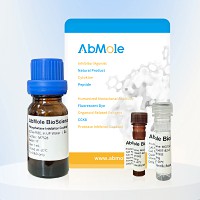All AbMole products are for research use only, cannot be used for human consumption.

Dispase II is a neutral protease that hydrolyzes the N-terminal peptide bonds of non-polar amino acid residues. It may be used for separating many tissues and cells grown in vitro. The enzyme is very gentle and does not damage cell membranes. It can also be used to prevent clumping in suspension cultures.
Enzyme activity: DispaseII ≥0.8 U/mg (37°C, using casein as substrate, pH 7.5)
Preparation Note
Activator: Optimal Ca2+ concentration is 2 mM. The enzyme preparations contain enough Ca2+ for optimal activity.
Inhibitors: EDTA, EGTA, Hg2+, other heavy metals. Dispase is not inhibited by serum.
Working concentration: 0.6 to 2.4 U/ml
Preparation of stock and working solutions:
To produce a 10 mg/ml stock solution, dissolve the lyophilized Dispase II enzyme in HEPES-buffered saline (50 mM HEPES/KOH pH 7.4, 150 mM NaCl). To produce the working solution, dilute the above stock solution with the culture medium for the isolated cells, at a final concentration of 0.6 to 2.4 U/ml. Note that concentrations higher than 2.4 U/ml are not recommended. For best results, filter the working solution using a 0.22 μm filter membrane.
Storage conditions (working solution): -20 °C
The reconstituted stock solution is stable at 2 to 8 °C for 2 weeks. For storage up to 2 months the stock solution should be frozen in aliquots. Avoid repeated freezing and thawing! The working solution diluted with PBS is stable at 2 to 8 °C for 3 days.
| CAS Number | 42613-33-2 |
| Solubility (25°C) | 50 mM HEPES/KOH pH 7.4 150 mM NaCl |
| Storage | Stable for 6-12 months after receipt, store at 2-8°C, dry, sealed |
[2] Jae-Kyung Lee, et al. Methods Mol Biol. Microglia isolation from adult mouse brain
[3] Mark Tomishima. Splitting hPSCs with Dispase
[4] Laurence S Lim, et al. Mol Vis. Effect of dispase denudation on amniotic membrane
| Related Cell Culture Products |
|---|
| Yeast Nitrogen Base (Without Amino Acids and Ammonium Sulfate)
Yeast Nitrogen Base Without Amino Acids and Ammonium Sulfate is recommended to use for classifying yeasts based on their carbon and nitrogen requirements. The medium contains all essential nutrients required for the growth of yeasts except amino acids, histidine, methionine and tryptophan, and also ammonium sulphate. The addition of nitrogen and carbon sources is required. |
| Poly-L-lysine (MW 70000~150000)
Poly-L-lysine is a positively charged amino acid polymer that can bind to DNA, red blood cell membranes, or any negatively charged protein. It is a non-specific cell adhesion factor that promotes cell adhesion to solid substrates. |
| MEISi-1
MEISi-1 is a homeodomain inhibitor of small molecule MEIS1 protein. MEISi-1 induced self-renewal of mouse and human HSCS in vitro and in vivo. MEISi-1 can be used for research in blood diseases, heart regeneration and cancer. |
| TCS 2210
TCS 2210 is a neuronal differentiation inducer in mesenchymal stem cells (MSCs). |
| (-)-Variabilin
(-)-Variabilin promotes differentiation of neural stem cells into neurons. (-)-Variabilin is an Neurogenin2 (Ngn2) promoter activator isolated from Butea superba. |
All AbMole products are for research use only, cannot be used for human consumption or veterinary use. We do not provide products or services to individuals. Please comply with the intended use and do not use AbMole products for any other purpose.


Products are for research use only. Not for human use. We do not sell to patients.
© Copyright 2010-2024 AbMole BioScience. All Rights Reserved.
